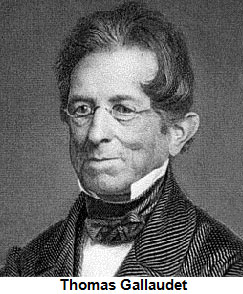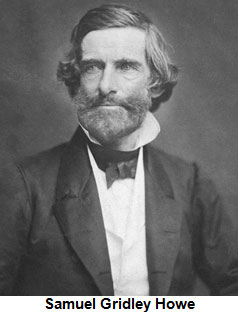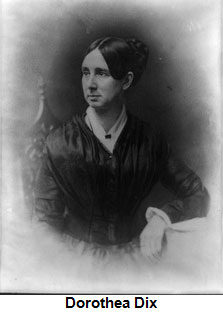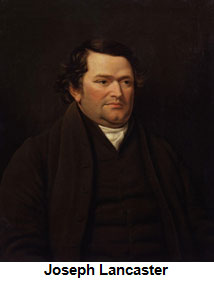
Source: Thomas Hopkins Gallaudet,
Materialscientist, Wikimedia

Source: Thomas Hopkins Gallaudet,
Materialscientist, Wikimedia
The 19th century saw a huge segregation of disabled people. With the impact of the Industrial Revolution, the workforce had to be more physically uniform to perform factory operations. Disabled people were rejected from employment and other segments of society. They were viewed as "worthy poor" and were given poor law relief (money from public funds). Disabled people became increasingly dependent on the medical profession for assistance.
The disability civil rights movement began in the early 19th century. Thomas Hopkins Gallaudet was one of the first reformers who worked on the behalf of the disabled. After earning a degree at Yale, he became interested in educating the deaf and learned sign language. In 1816, he founded the American Asylum for Deaf-Mutes, and for over 50 years the school trained most of the teachers of the deaf in the United States.

Source: Samuel Gridley Howe, Connormah, Wikimedia
Samuel Gridley Howe was another reformer for the disabled. Along with his work to reform the rights of the disabled, Howe was also an abolitionist. Additionally, he strongly believed in teaching the disabled life skills that would allow them to be viable employees in the workplace.
Howe founded the Perkins School for the Blind where he taught Braille. For his work, he was able to raise money for the disabled. Howe received much attention for teaching Braille (an alphabet for the blind) to a blind, deaf, and mute (unable to speak) student.

Source: Dorothea Lynde Dix, Library of Congress
During a Sunday school visit to a jail,
noticed that mentally disabled people were housed in the same facility as criminals. She began visiting other facilities to see how mentally disabled people were being treated. Soon after, Dix lobbied lawmakers on behalf of mentally disabled people who were confined to jails and insane asylums in poor conditions. Her efforts resulted in the government's taking more interest in the needs of the mentally disabled.
During the 19th century, there was also a movement to reform education. Many people were educated through apprenticeships or training on the job. The opportunity to attend schools was limited to those who could afford it and the few others who were able to attend charity schools for the poor.
Many schools admitted students of all ages, and there was no limit to the class sizes. Classes were overcrowded and many times without the proper resources, such as textbooks. School buildings were in disrepair. Educational reformers of the 19th century were focused on changing the conditions of schools and providing age-appropriate instruction.
Read about one of the reformers of education below:

Source: Joseph Lancaster by John Hazlitt, Dcoetzee, Wikimedia
Alcohol use had been an issue in the United States since the colonial days. People believed that excessive alcohol consumption led to a corruptive society. In the early 19th century, most groups that wanted to address the issue of alcohol use and alcoholism were religious-based, and they focused on limiting and restricting the sale and use of alcohol. The reform movement increased in size and scope and became known as the temperance movement.
The American Temperance Society was founded in 1826. Its main purpose was to find ways to convince people to stop drinking alcohol. The movement evolved into a ban on alcohol and drugs instituted by the Women's Christian Temperance Union. Many reform groups began to work within the temperance movement. The Anti-Saloon League was the most successful group, leading the efforts in passing the national ban on alcohol which led to Prohibition.
Women were strongly behind the temperance movement since alcohol was seen as the cause of destroyed families and marriages. Men would sometimes spend their money on alcohol, leaving women with no money to provide for their children. Factory owners supported temperance as well because of the new work habits that were required of workers in industrial jobs.
→ Analyzing a cartoon - This cartoon is an example of publications that supported the Temperance Movement. Who do you believe this cartoon is aimed at -- men, women, or both? Why do you think so? According to this cartoon, what happens to the men who continue to drink? How does drinking impact families, according to this cartoon?
The temperance movement continued full strength until the passage of the 18th amendment in 1919, which outlawed the manufacture, sale, and transportation of alcohol. The amendment did not stop the consumption of alcohol. The 18th Amendment was "repealed" by the 21st Amendment in 1933. The temperance movement finally dissolved soon after.
Overcrowding and abuse in most prisons was the focus of the prison reform movement. Jails and prisons were often used as a way to get rid of troublemakers as well as a source of cheap labor.
One of the most famous reformers of the prison reform movement was also a reformer for the disabled. Dorothea Dix was visiting a jail in Massachusetts with her Sunday school and discovered that the inmates were living in unsanitary and cold cells. Prisoners were also subject to beatings and harsh treatment by the prison guards. She was even more concerned about the mentally ill people who were mixed in with the prisoners. She visited prisons across the world and urged governments to improve the conditions in prisons.
The Quakers and other religious groups worked on creating humane prison conditions. Reformers also tried to improve prison conditions for women who were housed in small rooms in men's facilities. Societies such as the American Correctional Association pushed for better treatment and conditions of prisoners. There were successes in the movement such as the creation of female correctional facilities, the implementation of educational programs, and improvement of facility conditions.